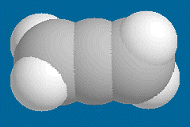 |
| Introduction |
| Symmetry Elements |
| · Proper Rotation Axis |
| · Mirror Plane |
| · Inversion Centre |
| · Improper Rotation Axis |
| · Identity |
| Point Group Gallery |
| Spotting a Chiral Compound |
| · Part I - Mirror Planes |
| · Part II - Inversion Centre |
| · Part III - Improper Rotation |
| · Summary & Conclusion |
| WSM Homepage |
Molecular Symmetry and Chirality
Mirror Plane
Note: viewing the structures on these pages requires use of
the MDL Chime Plug-In.
The σ operation reflects all the atoms of the molecule across a plane to a point an equal distance on the other side of the plane.
If the configuration of a molecule is unchanged as a result of this reflection, the molecule has a σ plane; in effect, one half of the molecule is the mirror image of the other.
A σ parallel to and containing the principal Cn axis is called a vertical plane, σv.
A σ parallel to the principal Cn axis and bisecting 2 C2' axes (or bisecting angles between atoms) is called a dihedral plane, σd.
A σ perpendicular to the principal Cn axis is called a horizontal plane, σh.
|
H2O has a 2 σv planes.
|
|
|
cis-Dibromodichloroplatinate(II) also has a two σv planes. Note that the principal C2 axis is in the molecular plane, so the second plane is not a σh.
|
|
|
1,3,5-Trichlorobenzene has three σv planes, as well as a σh.
|
This page is maintained and copyright by W. Stephen McNeil at UBC Okanagan.
.